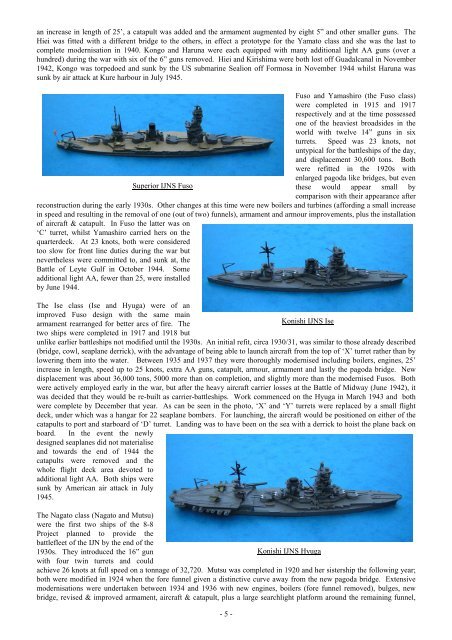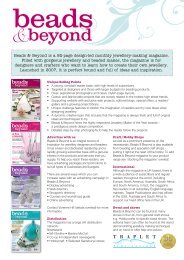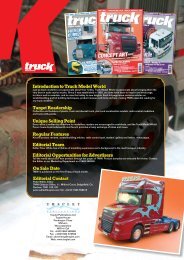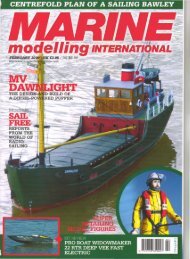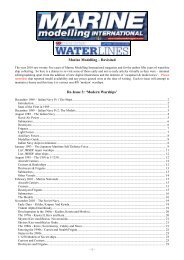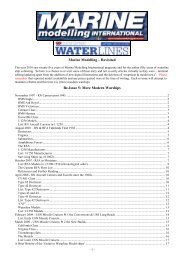Marine Modelling â Revisited Re-Issue 2: 'Foreign Warships'
Marine Modelling â Revisited Re-Issue 2: 'Foreign Warships'
Marine Modelling â Revisited Re-Issue 2: 'Foreign Warships'
You also want an ePaper? Increase the reach of your titles
YUMPU automatically turns print PDFs into web optimized ePapers that Google loves.
an increase in length of 25’, a catapult was added and the armament augmented by eight 5” and other smaller guns. The<br />
Hiei was fitted with a different bridge to the others, in effect a prototype for the Yamato class and she was the last to<br />
complete modernisation in 1940. Kongo and Haruna were each equipped with many additional light AA guns (over a<br />
hundred) during the war with six of the 6” guns removed. Hiei and Kirishima were both lost off Guadalcanal in November<br />
1942, Kongo was torpedoed and sunk by the US submarine Sealion off Formosa in November 1944 whilst Haruna was<br />
sunk by air attack at Kure harbour in July 1945.<br />
Fuso and Yamashiro (the Fuso class)<br />
were completed in 1915 and 1917<br />
respectively and at the time possessed<br />
one of the heaviest broadsides in the<br />
world with twelve 14” guns in six<br />
turrets. Speed was 23 knots, not<br />
untypical for the battleships of the day,<br />
and displacement 30,600 tons. Both<br />
were refitted in the 1920s with<br />
enlarged pagoda like bridges, but even<br />
Superior IJNS Fuso<br />
these would appear small by<br />
comparison with their appearance after<br />
reconstruction during the early 1930s. Other changes at this time were new boilers and turbines (affording a small increase<br />
in speed and resulting in the removal of one (out of two) funnels), armament and armour improvements, plus the installation<br />
of aircraft & catapult. In Fuso the latter was on<br />
‘C’ turret, whilst Yamashiro carried hers on the<br />
quarterdeck. At 23 knots, both were considered<br />
too slow for front line duties during the war but<br />
nevertheless were committed to, and sunk at, the<br />
Battle of Leyte Gulf in October 1944. Some<br />
additional light AA, fewer than 25, were installed<br />
by June 1944.<br />
The Ise class (Ise and Hyuga) were of an<br />
improved Fuso design with the same main<br />
armament rearranged for better arcs of fire. The<br />
Konishi IJNS Ise<br />
two ships were completed in 1917 and 1918 but<br />
unlike earlier battleships not modified until the 1930s. An initial refit, circa 1930/31, was similar to those already described<br />
(bridge, cowl, seaplane derrick), with the advantage of being able to launch aircraft from the top of ‘X’ turret rather than by<br />
lowering them into the water. Between 1935 and 1937 they were thoroughly modernised including boilers, engines, 25’<br />
increase in length, speed up to 25 knots, extra AA guns, catapult, armour, armament and lastly the pagoda bridge. New<br />
displacement was about 36,000 tons, 5000 more than on completion, and slightly more than the modernised Fusos. Both<br />
were actively employed early in the war, but after the heavy aircraft carrier losses at the Battle of Midway (June 1942), it<br />
was decided that they would be re-built as carrier-battleships. Work commenced on the Hyuga in March 1943 and both<br />
were complete by December that year. As can be seen in the photo, ‘X’ and ‘Y’ turrets were replaced by a small flight<br />
deck, under which was a hangar for 22 seaplane bombers. For launching, the aircraft would be positioned on either of the<br />
catapults to port and starboard of ‘D’ turret. Landing was to have been on the sea with a derrick to hoist the plane back on<br />
board. In the event the newly<br />
designed seaplanes did not materialise<br />
and towards the end of 1944 the<br />
catapults were removed and the<br />
whole flight deck area devoted to<br />
additional light AA. Both ships were<br />
sunk by American air attack in July<br />
1945.<br />
The Nagato class (Nagato and Mutsu)<br />
were the first two ships of the 8-8<br />
Project planned to provide the<br />
battlefleet of the IJN by the end of the<br />
1930s. They introduced the 16” gun<br />
Konishi IJNS Hyuga<br />
with four twin turrets and could<br />
achieve 26 knots at full speed on a tonnage of 32,720. Mutsu was completed in 1920 and her sistership the following year;<br />
both were modified in 1924 when the fore funnel given a distinctive curve away from the new pagoda bridge. Extensive<br />
modernisations were undertaken between 1934 and 1936 with new engines, boilers (fore funnel removed), bulges, new<br />
bridge, revised & improved armament, aircraft & catapult, plus a large searchlight platform around the remaining funnel,<br />
- 5 -


